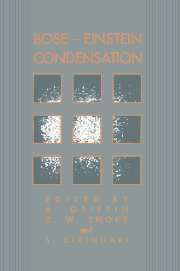Book contents
- Frontmatter
- Contents
- Preface
- Preface to paperback edition
- 1 Introduction: Unifying Themes of Bose–Einstein Condensation
- Part one Review Papers
- 2 Some Comments on Bose–Einstein Condensation
- 3 Bose–Einstein Condensation and Superfluidity
- 4 Bose-Einstein Condensation in Liquid Helium
- 5 Sum Rules and Bose–Einstein Condensation
- 6 Dilute-Degenerate Gases
- 7 Prospects for Bose–Einstein Condensation in Magnetically Trapped Atomic Hydrogen
- 8 Spin-Polarized Hydrogen: Prospects for Bose–Einstein Condensation and Two-Dimensional Superfluidity
- 9 Laser Cooling and Trapping of Neutral Atoms
- 10 Kinetics of Bose–Einstein Condensate Formation in an Interacting Bose Gas
- 11 Condensate Formation in a Bose Gas
- 12 Macroscopic Coherent States of Excitons in Semiconductors
- 13 Bose–Einstein Condensation of a Nearly Ideal Gas: Excitons in Cu2O
- 14 Bose–Einstein Condensation of Excitonic Particles in Semiconductors
- 15 Crossover from BCS Theory to Bose–Einstein Condensation
- 16 Bose–Einstein Condensation of Bipolarons in High-Tc Superconductors
- 17 The Bosonization Method in Nuclear Physics
- 18 Kaon Condensation in Dense Matter
- 19 Broken Gauge Symmetry in a Bose Condensate
- Part two Brief Reports
- Appendix. BEC 93 Participant List
- Index
12 - Macroscopic Coherent States of Excitons in Semiconductors
Published online by Cambridge University Press: 15 December 2009
- Frontmatter
- Contents
- Preface
- Preface to paperback edition
- 1 Introduction: Unifying Themes of Bose–Einstein Condensation
- Part one Review Papers
- 2 Some Comments on Bose–Einstein Condensation
- 3 Bose–Einstein Condensation and Superfluidity
- 4 Bose-Einstein Condensation in Liquid Helium
- 5 Sum Rules and Bose–Einstein Condensation
- 6 Dilute-Degenerate Gases
- 7 Prospects for Bose–Einstein Condensation in Magnetically Trapped Atomic Hydrogen
- 8 Spin-Polarized Hydrogen: Prospects for Bose–Einstein Condensation and Two-Dimensional Superfluidity
- 9 Laser Cooling and Trapping of Neutral Atoms
- 10 Kinetics of Bose–Einstein Condensate Formation in an Interacting Bose Gas
- 11 Condensate Formation in a Bose Gas
- 12 Macroscopic Coherent States of Excitons in Semiconductors
- 13 Bose–Einstein Condensation of a Nearly Ideal Gas: Excitons in Cu2O
- 14 Bose–Einstein Condensation of Excitonic Particles in Semiconductors
- 15 Crossover from BCS Theory to Bose–Einstein Condensation
- 16 Bose–Einstein Condensation of Bipolarons in High-Tc Superconductors
- 17 The Bosonization Method in Nuclear Physics
- 18 Kaon Condensation in Dense Matter
- 19 Broken Gauge Symmetry in a Bose Condensate
- Part two Brief Reports
- Appendix. BEC 93 Participant List
- Index
Summary
Abstract
Initially put forward by Moskalenko and Blatt et al., the idea of a possible Bose–Einstein condensation (BEC) of excitons in semiconductors has attracted the attention of both experimentalists and theoreticians for more than three decades. At different stages of this long history, the results of their efforts have been described and discussed in review articles. A brief introduction and summary of the main qualitative conclusions of this older work is presented here (Sections 1 and 2), followed by a more detailed discussion of some more recent developments (Sections 3 and 4).
Electronic Excitations in Semiconductors
Schematically presented in Fig. 1 is the typical electronic spectrum of a semiconductor: two bands (or two groups of bands) of continuous spectrum – conduction (c) and valence (v) – separated by the energy gap Eg = Ec,min – EV,max. In the ground state, all of the states in the valence band(s) are occupied by valence electrons of the semiconductor, and all states in the conduction band are empty.
The lowest single-particle electronic excitations are an additional electron (e) in the conduction band or a single empty state – a hole (h) – in the valence band. Both of these excitation types are mobile fermions (spin = 1/2) characterized by effective masses, me and mh, and effective charges ee = e and eh = −e, respectively. Here e is the usual (negative) elementary charge.
- Type
- Chapter
- Information
- Bose-Einstein Condensation , pp. 246 - 280Publisher: Cambridge University PressPrint publication year: 1995
- 11
- Cited by

